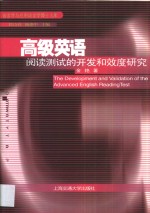

高级英语阅读测试的开发和效度研究 英文本PDF电子书下载
- 电子书积分:17 积分如何计算积分?
- 作 者:金艳著
- 出 版 社:上海:上海交通大学出版社
- 出版年份:2002
- ISBN:7313030991
- 页数:562 页
List of Figures 1
List of Tables 3
CHAPTER1 INTRODUCTION 5
1.1 Types of Reading Research 6
1.1.1 Process-Oriented Psycholinguistic Approach 9
1.1.2 Product-Oriented Applied Linguistic Approach 12
1.2 Aims of the Study 16
1.2.1 Rationale for the Study 17
1.2.2 Research Questions and Stages of the Research Ptoject 20
CHAPTER2 MODELS OF READING 27
2.1 Criteria for Judging Models of Reading 28
2.2 Linear Models of the Reading Process 31
2.2.1 Bottom-up Models 31
2.2.2 Top-down Models 35
2.2.3 Judging Linear Models against the Criteria 39
2.3 Schema Theory 41
2.3.1 Origin and Development 42
2.3.2 Knowledge Structure and Activation of Schema 46
2.3.3 Schema-Theoretic Views of Reading 50
2.3.4 Empirical Studies on the Effect of Background Knowledge 53
2.4 Interactive Models 59
2.4.1 From Linear Models to Interactive Models 59
2.4.2 The Interactive Models 61
2.4.3 Judging Interactive Models against the Criteria 78
CHAPTER3 EFL READING RESEARCH 83
3.1 Models of EFL reading 84
3.1.1 Sequential Process Models of EFL Reading 85
3.1.2 Componential Models of EFL Reading 88
3.2 The Controversy : Unitary or Componential Construct of Reading 98
3.3 Skills and Strategies in EFL Reading 104
3.4 Implications from the Literature Review for the WERT 110
CHAPTER4 CHINESE READERS AND EAP READING:WHAT'S SPECIAL? 116
4.1 Difficulties in EFL Reading by Chinese Readers 116
4.1.1 Difficulties in Applying Linguistic Skills 117
4.1.2 Difficulties in Employing Reading Strategies 128
4.1.3 Difficulties in Background Knowledge 134
4.1.4 Implications for the Teaching and Testing of EFL Reading in China 136
4.2 EAP Reading: What's Special? 139
4.2.1 Rhetorical Organizations of EAP Texts 141
4.2.2 Effects of Rhetorical Organization on Comprehension and Recall 146
4.2.3 A Model for Establishing Text Structures in Reading 154
4.2.1 Implications for the AERT 159
CHAPTER5 EAP READING NEEDS AND TEACHING AND TESTING TASKS 161
5.1 A Needs Analysis of Chinese Undergraduates's EAP Reading 161
5.1.1 Design of the Questionnaire 161
5.1.2 Responses to the Questionnaire 162
5.1.3 Results of the Survey 164
5.1.4 Implications of the Needs Analysis for the AERT 170
5.2 An Analysis of Texts and Tasks in Published EAP Textbooks and Tests 172
5.2.1 Identification of the Textbooks and Tests 172
5.2.2 Analysis of Skills and Strategies 173
5.2.3 Analysis of Performance Conditions 180
5.2.4 Implications for the Development of the AERT 187
CHAPTER6 CONSTRUCT VALIDITY AND THE AERT TEST SPECIFICATIONS 191
6.1 Developments in the Testing of Reading 192
6.1.1 Reading Research and the Testing of Reading 192
6.1.2 Stages of the Developments in the Testing of Reading 193
6.2 The AERT Test Specifications 198
6.2.1 Operations: Reader-Based Factors 199
6.2.2 Conditions: Text-and Task-Based Factors 219
CHAPTER7 OPERATIONALIZING THE CINSTRUCT:TEST DEVELIPMENT 228
7.1 Text Selection-Operationalizing Conditions 228
7.1.1 Initial Selection by Individual Researchers 229
7.1.2 Subject Teacher Questionnaire Survey for Text Suitability 232
7.1.3 Matching the Selected Texts with the Test Conditions 235
7.1.4 Making Decisions on the Most Suitable Texts 239
7.2 Text Mapping_ Operationalizing Tasks 239
7.2.1 Purposes of Text Mapping 239
7.2.2 Methods 240
7.2.3 Participants 242
7.2.4 Results 243
7.3 Task Construction 243
7.3.1 Decision on a Modular on a General Test 243
7.3.2 Decision on Test Formats 245
7.3.3 Considerations of Other Test Conditions 246
7.4 A Description of the AERT Prototype Version 1 248
CHAPTER8 THE A POSTERIORI VALIDATION OF THE AERT ——QUANTITATIVE STUDIES 252
8.1 First Trial 254
8.1.1 Test Administration 254
8.1.2 Sample 254
8.1.3 Marking and Data Entry 254
8.1.4 Descriptives of the Test Data 255
8.1.5 Factor Analyses 255
8.1.6 Cross-Tabulations 258
8.1.7 Questionnaire Survey 259
8.1.8 Conclusions 260
8.2 The Main Trial 263
8.2.1 Test Administration 263
8.2.2 Sample 264
8.2.3 Marking and Data Entry 265
8.2.4 Descriptives of the Test Data 267
8.2.5 P.C.A. and Varimax Rotation 267
8.2.6 Cross-Tabulations 269
8.2.7 ANOVA Analyses of Differences between Test Sub-Components 270
8.2.8 Analysis of Questionnaire Data 271
8.2.9 Conclusions 274
CHAPTER9 THE A POSTERIORI VALIDATION OF THE AERT——QUALITATIVE STUDIES 281
9.1 Expert Judgments 281
9.1.1 Data Collection 282
9.1.2 Data Analysis 282
9.1.3 Conclusions 285
9.2 Student Retrospection 285
9.2.1 Data Collection 285
9.2.2 Data Analysis 286
9.2.3 Conclusions 291
9.3 Student Introspection 292
9.3.1 Data Collection 292
9.3.2 Tape Transcription 297
9.3.3 Data Analysis 298
9.3.4 Conclusions 313
CHAPTER10 CONCLUSIONS 316
10.1 An Applied Linguistics Model of Chinese Undergraduates' EAP Reading 316
10.1.1 An Applies Linguistics Model 318
10.1.2 A Componential Model 320
10.1.3 A Model of Chinese Undergraduates'EAP Reading 325
10.2 The Operationalizations of the Construct in the AERT 327
10.2.1 The Validity of the AERT 328
10.2.2 The Reliability of the AERT 330
10.2.3 The Reliability of the Test 330
10.2.4 Some Other Recommendations 334
Bibliography 337
Appendices 356
- 《红色旅游的社会效应研究》吴春焕著 2019
- 《高级英语阅读与听说教程》刘秀梅编著 2019
- 《汉语词汇知识与习得研究》邢红兵主编 2019
- 《生物质甘油共气化制氢基础研究》赵丽霞 2019
- 《东北民歌文化研究及艺术探析》(中国)杨清波 2019
- 《联吡啶基钌光敏染料的结构与性能的理论研究》李明霞 2019
- 《异质性条件下技术创新最优市场结构研究 以中国高技术产业为例》千慧雄 2019
- 《《国语》和《战国策》词汇比较研究》陈长书著 2017
- 《中国制造业绿色供应链发展研究报告》中国电子信息产业发展研究院 2019
- 《行政保留研究》门中敬著 2019
- 《这样定规矩 孩子愿接受》刘艳著 2019
- 《排舞运动价值解析与学练指导》侯晓艳著 2019
- 《冯舒、冯班诗学研究》周小艳著 2018
- 《环太湖出入湖河道污染物通量》杨金艳主编 2019
- 《纳米技术改性水泥基材料》李海艳著 2019
- 《有机化学》张金艳,王亚飞
- 《图像天津与想象天津》陈艳著 2019
- 《追梦赤子》余艳著 2017
- 《湾木腊密码》陆辉艳著 2019
- 《广西科技创新创业人才发展与政策研究》唐青青,陆桂军,董婷梅,陆艳著 2017
